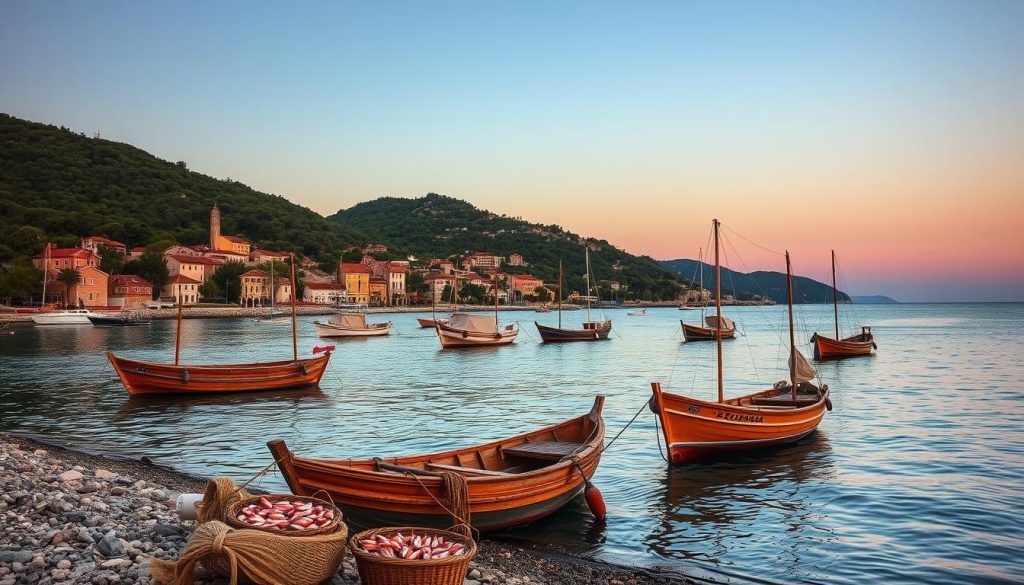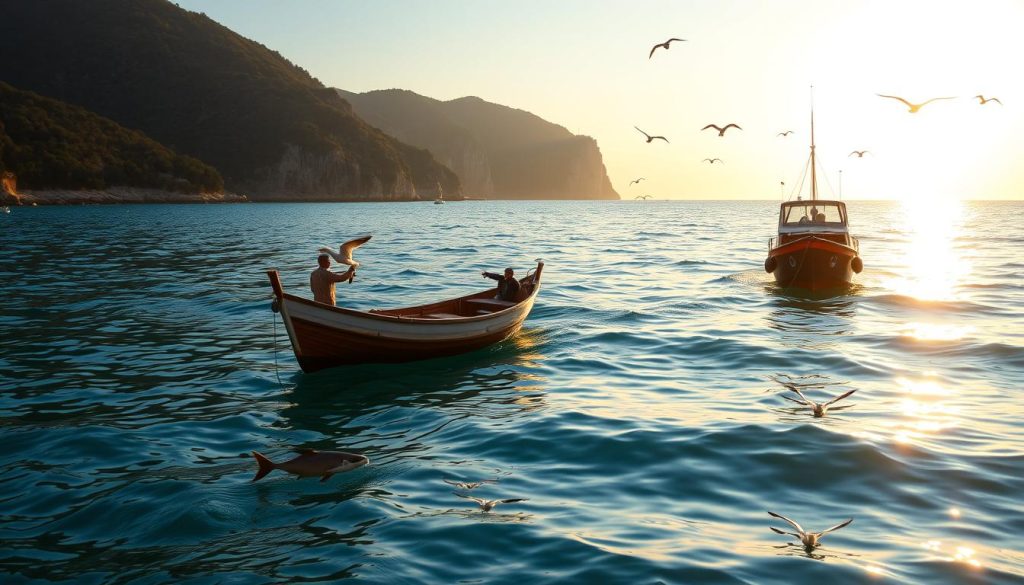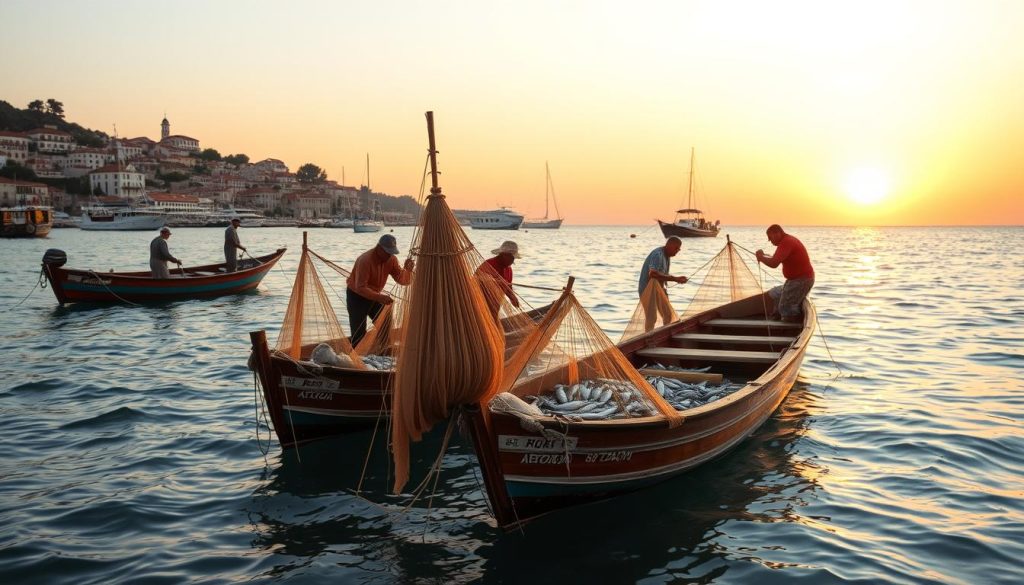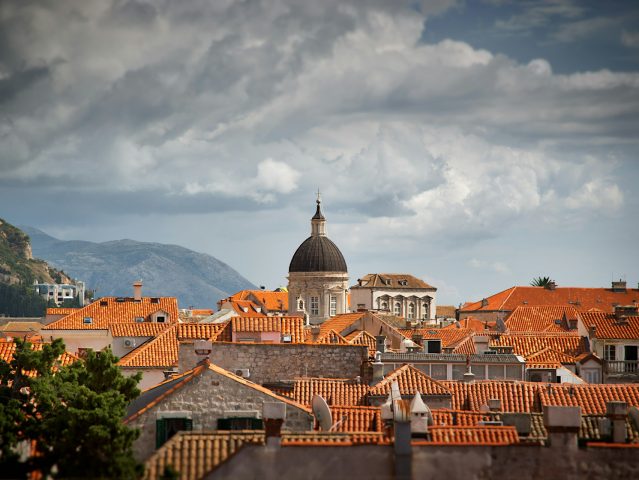Croatia’s rich maritime heritage is filled with captivating fishing legends.

These stories, spanning centuries, showcase the courage, ingenuity, and resilience of Croatian fishermen. From ancient fishing communities to modern innovations1, they have shaped the coastal culture.
With 5 fish folklore stories from around the world, including China, Brazil, and Australia, we’re about to explore Croatia’s Adriatic Sea angling traditions. These stories have defined Croatia’s unique culture1.
The Adriatic Sea has been a source of livelihood and inspiration for generations. It has led to the development of legendary fishing techniques and customs. These continue to influence Croatian culture today2.
From the majestic Cetina River to the stunning Plitvice Lakes and Krka National Park, Croatia’s maritime heritage is woven into its landscape2. Join us as we uncover the captivating stories of Croatia’s legendary fishermen. Their remarkable contributions to the country’s rich Croatian fishing heritage are truly inspiring.
The Rich Maritime Heritage of Croatian Fishing
Croatia’s fishing communities along the Adriatic coast have a long history. These communities developed unique historic Croatian fishing communities and traditional Croatian fishing techniques. These traditions have deeply influenced Croatia’s Croatia’s fishing legacy.
From traditional wooden boats to specialized fishing nets, the coastal fishing culture has made a lasting impact. It has shaped local cuisine, folklore, and even the growth of coastal towns.
Ancient Fishing Communities Along the Adriatic
The fishing communities of Croatia’s Adriatic coastline have a history that goes back thousands of years. These settlements were influenced by the sea’s rhythms. They developed specialized techniques and customs to harvest marine resources3.
The legacy of these historic Croatian fishing communities is still felt today. Traditional methods are practiced alongside modern fishing, preserving Croatia’s Croatia’s fishing legacy.
Traditional Fishing Methods and Customs
The traditional Croatian fishing techniques show the ingenuity and resilience of Croatia’s fishermen. From wooden boats to intricate fishing nets, these skills have been passed down through generations3. These techniques have created a unique Croatia’s fishing legacy.
The sea’s rhythms have also influenced the customs and folklore of these communities. This has further integrated coastal fishing into Croatia’s culture.
Impact on Croatian Culture
The historic Croatian fishing communities and their traditions have deeply influenced Croatian culture. They have shaped local cuisine and the architecture of coastal towns. The abundance of seafood has influenced iconic Croatian dishes4.
The unique maritime aesthetic has inspired art, music, and literature4. The close relationship between people and the sea has also given rise to a rich tradition of folklore and superstition. This has further cemented the importance of Croatia’s fishing legacy in the national identity.
The enduring legacy of Croatia’s historic Croatian fishing communities and their traditional Croatian fishing techniques shows the resilience and ingenuity of coastal residents. As modern fishing practices evolve, the Croatia’s fishing legacy remains a vital part of the nation’s cultural heritage. It preserves the unique connection between people and the sea.
5 Fishing Legends of Croatia – Tales of Courage and Innovation
Croatia’s fishing history is filled with stories of brave and innovative fishermen. These Croatian fishing personalities and Croatian fishing pioneers have left a lasting mark. Their stories of hard work and creativity are part of Croatia’s rich sea folklore5.
These famous Croatian fishermen and Croatia’s angling heroes brought new technologies and explored new fishing areas. They also set up international trade networks. Their work inspires and guides the next generation of fishermen and entrepreneurs6.
In this section, we explore the amazing stories of five fishing legends. Each one made a unique contribution to Croatia’s fishing history. Their stories of courage and innovation highlight the richness and diversity of Croatia’s fishing industry5.
| Fishing Legend | Key Contributions |
|---|---|
| Ivan Skomerža | Pioneered the use of motorized fishing vessels in the Mediterranean |
| Josip Ressel | Invented the propeller, revolutionizing maritime navigation |
| Nikola Vučković | Established the first international fish trade network from Croatia |
| Antun Dobrinić | Developed innovative fish processing techniques, transforming the industry |
| Frano Barović | Led daring expeditions to distant fishing grounds, expanding Croatia’s reach |
These famous Croatian fishermen and Croatian fishing pioneers continue to inspire today’s fishing industry. Their stories of courage and innovation are a key part of Croatia’s sea heritage6.
“Their tales of perseverance and ingenuity have become an integral part of Croatia’s maritime folklore, inspiring future generations of fishermen and maritime entrepreneurs.”
Ivan Skomerža: Pioneer of Modern Mediterranean Fishing
The Croatian fishing industry is rich and full of pioneers. Ivan Skomerža from Crikvenica changed fishing in the early 1900s. He came from the coastal town of Crikvenica.
The First Motorized Fishing Fleet
In 1908, Skomerža launched the first motorized fishing boat, the Dinko Vitezić. This was a big change for Mediterranean fishing3. He then built more motorized trawlers and started Nekton, the first shareholding fishing society on the Adriatic, in 19123.
Revolutionary Fishing Technologies
Skomerža was a true innovator. He introduced supply boats, autonomous freezers, and wider trawl nets3. He was also the first to use purse seines and petroleum lamps for night fishing in the Mediterranean, beating his Italian rivals3.
Legacy in Mediterranean Maritime History
Skomerža’s work made him a key fishing icon and renowned Croatian fishing pioneer. His achievements are honored in the Croatia’s fishing hall of fame. His innovations changed Mediterranean fishing and inspired future fishermen.
“Skomerža’s motorized fishing fleet and revolutionary technologies set the stage for a new era of efficient and sustainable Mediterranean fishing.”
The Legendary Fishermen of Komiza
Komiza, on the island of Vis, is famous for its legendary fishermen. They were key in building Croatia’s Dalmatian coast fishing industry7. In 1870, Komiza started the first fish cannery in Dalmatia, using the Nantes method. The town’s spirit led to more factories and fishing in Portugal and Spain7.
Komiza’s fishermen were the first to salt sardines and anchovies in Spain. This helped create Europe’s biggest fishing port in La Coruna.
Komiza’s fishing history is tied to its sea heritage7. The falkuša, a unique fishing boat, is in the Fishermen’s Museum. It shows the skill of these legendary sailors7. The town celebrates St. Mikula on December 6th with a burning of a falkuša, a tradition for centuries8.
This ritual honors Komiza’s maritime traditions. It’s a big part of the town’s identity.
Komiza also has stories like Gusarica, a small Renaissance church tied to pirate lore7. The island of Biševo, with its Blue Cave, is special to Komiza’s fishermen7. Palagruža, with its 19th-century lighthouse, is another famous spot for these sailors.
Komiza’s fishing history shows the town’s people’s ingenuity and spirit7. From the falkuša boats to its cultural traditions, Komiza’s fishermen have made a lasting impact. They’ve shaped Croatia’s iconic Croatian fishing destinations, legendary Croatian fishing spots, and Croatia’s best fishing destinations.
“The sea is not just a source of livelihood for us, but a way of life that has been passed down through generations. In Komiza, the stories of our fishermen are written in the waves, their legacy etched into the very fabric of our town.” – Local Resident
Josip Ressel: The Visionary Who Changed Maritime Navigation
Croatian fishing history is filled with stories of innovators who changed the sea. Josip Ressel, a forester from Motovun, Istria, invented the boat propeller in 18279. He tested it on the steamboat Civetta in Trieste’s harbor in 18299. This invention made fishing boats more efficient and powerful9.
The Invention of the Propeller
Ressel faced challenges but kept working on his idea in Šibenik. He wanted to change how boats moved on the water9. His invention made boats faster, more fuel-efficient, and easier to steer9.
Impact on Modern Fishing Vessels
Ressel’s work led to the modern fishing boats we see today. His propeller made boats more agile and efficient9. This change helped fishermen reach new places and catch more fish9. Ressel’s invention is a key part of Croatian fishing’s history9.
“Josip Ressel’s invention of the propeller revolutionized maritime navigation and had a lasting impact on the fishing industry, shaping the rich history and evolution of Croatian fishing.” – Fishing Historian
The Daring Expedition to Lampedusa
In the late 19th century, Croatian fishermen from Hvar set out for Lampedusa, a small Italian island near Tunisia10. Tomas Novak led the group, finding rich fishing spots. They used 32 boats to catch 12,000 to 14,000 barrels of sardines each season10.
This adventure showed the bravery and skill of Croatian fishermen. They sold their salted fish in the Levant and Italy, reaching beyond the Adriatic.
Dubrovnik, known as Ragusa, has a long history. It started in the seventh century with Greek refugees and grew into a major sea power10. Today, Dubrovnik, called the Pearl of the Adriatic, is quieter due to the pandemic10.
The history of Croatian sport fishing is filled with stories of bravery and skill. The fishermen from Hvar led the way in the late 19th century. Their journey to Lampedusa showed their innovation and adventurous spirit.

The Croatian fishing industry has a rich history. It has ancient fishing communities, traditional methods, and a big impact on culture. The Hvar fishermen’s journey to Lampedusa is just one of the many amazing stories in Croatian sport fishing history.
Croatian Fishing Pioneers in the Atlantic Waters
Croatian fishermen bravely explored the Atlantic, making a big mark in Portugal and Spain11. The oldest Croatian Guild in Italy was set up in 1375 in Recanti, starting our global trade11. Almost 20% of Venice’s Castello had Croatians, showing our strong maritime skills11.
The Portuguese Connection
Captains Vicko and Jakov Novak from Hvar were the first to venture into the Atlantic, starting a fish cannery in Lagos, Portugal11. This business is still run by the Novak family, showing the lasting impact of Croatian fishing11. Their work helped Croatian fishermen gain international fame and built a strong fish trade network.
Establishment of International Fish Trade
The Croatian presence in Portugal and Spain was a key moment in our fishing history11. The Guild of St Juraj and Tripun, founded in 1451, and the Guild of St. Jerome in Udine, set up in 1452, helped grow the fish trade11. The Collegium Illyricum in Bologna, started in 1553, and the one in Loreto, established in 1580, boosted our education and cultural exchange, teaching over 1,000 Croatian students for centuries11.
These early efforts made Croatia a key player in the global fishing world, inspiring today’s sport fishing heroes and tourism12
From ancient sea roots to today’s fishing families, the tale of Croatian pioneers in the Atlantic is a story of our nation’s courage, creativity, and global reach12.
The Story of Dalmatian Fish Processing Innovation
Dalmatia, a beautiful coastal area in Croatia, has been at the heart of the fishing industry for a long time. The town of Komiza is especially known for leading in fish processing. It has changed the industry a lot13.
In 1870, Komiza started its first fish cannery. Fishermen there began frying fish in olive oil before canning it, following the Nantes tradition3. This method made fish last longer and added new tastes to the world’s seafood market13.
This innovation quickly spread through Dalmatia, with more canneries popping up everywhere. It helped the local economy grow and made Croatia famous in the Mediterranean fish processing world3.
Dalmatia’s food culture is closely tied to its fishing traditions. The area loves to grill, boil, and stew fresh seafood. They use Croatian fish species like dog’s tooth, sea bass, and mackerel in these dishes13. They also enjoy a variety of mollusks, crustaceans, and shellfish, all cooked perfectly with Croatian fishing techniques passed down through generations13.
Inland areas, like the Neretva valley, are famous for their dishes too. They serve frog, eel, and river crab, among others13. This mix of sea and land flavors has created a rich and varied food scene in Croatia13.
Dalmatia’s rich fishing history and innovative processing methods have deeply influenced Croatia’s culture and food. They have left a lasting impact on the world14.

Heroes of the Costa da Morte
In the early 1900s, brave Croatian fishermen from Komiža island ventured into Spain’s Costa da Morte, known as “Coast of Death.” These legendary Croatian anglers15 were known for their courage and sea skills. They built a fishing empire that changed the industry forever.
The Brave Fishermen of Finisterre
Leaders like Dinko Bozanic Pepe led these15 Croatian pioneers. They faced the Atlantic’s dangers to start salting sardines on Cape Finisterre. Their bold moves and skills turned the fishing scene in the area, making La Coruna Europe’s biggest fishing port.
Creating a Fishing Empire
The15 Komizan fishermen’s adventures on the Costa da Morte showed their skill and adaptability. They used their maritime knowledge and new fishing methods to impact Galicia’s fishing industry. Their work merged Croatian and Spanish fishing traditions.
The tales of these15 Croatian fishing legends15 are a testament to their bravery. They braved the Costa da Morte to build a fishing empire. Their stories highlight the impact of legendary Croatian anglers on fishing history.
| Key Figures | Contributions |
|---|---|
| Dinko Bozanic Pepe | Led the establishment of wooden buildings for salting sardines on Cape Finisterre, laying the foundation for Europe’s largest fishing port in La Coruna. |
| Komizan Fishermen | Braved the dangerous Costa da Morte, showcasing their navigational prowess and innovative fishing techniques. Significantly influenced the fishing industry in Galicia, Spain. |
“The stories of these Croatian fishing pioneers, who braved the treacherous waters of the Costa da Morte to establish a fishing empire, stand as a testament to the legendary Croatian anglers who have left an indelible mark on the annals of fishing history.”
The15 Komizan fishermen’s legacy still inspires today. It shows the spirit and creativity of15 Croatia’s celebrated fishing personalities and the15 greatest figures in Croatian fishing history.
Modern Croatian Fishing Heritage
Croatia’s angling history and fishing legacy go back a long way. They started with ancient sea traditions and the work of famous Croatian fishermen. Looking at the Croatian fishing hall of fame, we see how the country’s fishing today shows the people’s spirit and creativity.
People like Ivan Skomerža and the fishermen of Komiza have left a big mark16. They started a new chapter in fishing, using new methods and technology. This made Croatia important in the Mediterranean fishing world.
Anglers in Croatia follow old traditions but also use new ways17. The Adriatic coast and towns like Split are beautiful places for fishing. Over 1,000 islands and places like Plitvice Lakes National Park add to the beauty of fishing here.
The Adriatic Sea: A Maritime History and Croatia’s Wildlife: The Untold Tales documentaries show Croatia’s fishing heritage17. They tell us about the hard work and flexibility of coastal communities. These stories help guide Croatia’s fishing into the future.
The Croatian fishing hall of fame honors Croatia’s dedication to its sea heritage17. It reminds us of the bravery, creativity, and hard work that have shaped Croatia’s fishing history.
“The sea has always been a part of us, shaping our way of life and our identity. As we look to the future, we carry the lessons of our angling history and the spirit of our fishing legacy to guide us.” – A Croatian Fisherman
The Legacy of Croatian Fishing Innovations
Croatia’s fishing industry has a long history of innovation. It has made a big impact on how we fish globally. Josip Ressel invented the propeller, and Ivan Skomerža introduced motorized fishing fleets. These innovations by Croatia’s top anglers have changed how we fish18.
The creativity of Croatia’s fishing legends has grown the fishing industry. They also set up international trade and processing facilities. These efforts have shaped the modern global market18. Their stories of bravery, innovation, and love for the sea inspire many.
We celebrate Croatia’s rich maritime history today. It’s thanks to the vision of its fishing pioneers. Their work has moved the fishing industry forward and changed how we use the sea’s resources19. Their legacy inspires fishermen and sea lovers worldwide.











